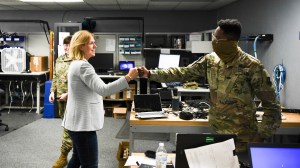
The National Archives recently declassified documents showing design diagrams for the Avrocar, a flying saucer look-a-like unsuccessfully developed by the U.S. Air Force in the 1950s.
Information about the aircraft – there are two prototypes in existence – has been available for years, but the documents now include diagrams that clearly demonstrate the scope of the project.
“The Avrocar was a good start, and the first step on a long road to discovering technology we use today,” said Jeff Underwood, National Museum of the U.S. Air Force historian. “Although the project was never implemented, it serves a successful teaching tool.”
“This project was far ahead of its time,” said Underwood. ” It was a perfect concept, but the technology of the time wasn’t advanced enough.”
Although the testing was deemed a failure by the engineers and pilots who spearheaded the experimentation, the implications of the Avrocar’s technology had far-reaching results.
“Just because the tests weren’t successful, doesn’t mean it was a failure,” said Underwood. “This experiment started engineers down a path to more innovative concepts based on what was learned.”
Technology used by many aircraft, like the AV-8B Harrier II, V-22 Osprey and the F-22 Raptor, can trace its history back to the Avrocar.
The U.S. Air Force gives a description of the history of the project:
The Avrocar was the result of a Canadian effort to develop a supersonic fighter-bomber, capable of vertical takeoff and landing, in the early 1950s. The Idea of what was to become the Avrocar was originally envisioned by British Aircraft designer, Jack Carver Meadows Frost.
A.V. Roe, a Canadian aircraft manufacturing company, along with Frost, based its design concept for the Avrocar on using the exhaust from turbojet engines to drive a circular rotor to produce thrust. By directing this thrust downward, it was believed the turbo-rotor could create a cushion of air under the aircraft, allowing it to float a few feet off the ground, as well as accelerate to high speeds at higher altitudes.
The Canadian government provided initial funding for the prototype, but dropped the project when it became too expensive. Avro offered the project to the U.S. government, and the U.S. Army and U.S. Air Force took over testing in 1955. Although the project primarily remained in Canada, it was owned and controlled by the U.S. government.
While testing was a combined effort, both services were interested in the project for different reasons. The Army was interested in a durable and adaptable, all-terrain transport and reconnaissance aircraft. The Army Intended the Avrocar to replace their light observation craft and helicopters.
The Air Force was interested in the Avrocar’s vertical take-off and landing capabilities, which could potentially hover below enemy radar and accelerate to supersonic speed.
Research data originally indicated that a circular design may have satisfied both service’s requirements. A.V. Roe built two, small test models to prove the concept.
Tests with scale models at Wright-Patterson AFB indicated the cushion of air under the Avrocar would become unstable when the aircraft passed roughly three feet off the ground. It was determined the aircraft was not incapable of reaching supersonic speeds, nor would the circular shape of the craft allow the Avrocar to have stealth capabilities. Although the aircraft did not meet the expectations of the Air Force, testing was continued to examine if a suitable model could be developed to fit the Army’s needs.
The first prototype was sent to the National Aeronautics and Space Administration’s Ames Research Center at Moffett Field, Calif. Wind-tunnel tests proved the aircraft had insufficient control for high speed flight and was aerodynamically unstable. Although engineers attempted to perfect the design, the project was marred with problems.
The second Avrocar prototype underwent flight tests. Project engineers discovered once the craft rose beyond three feet above the ground, it displayed uncontrollable pitch and roll motions. The lack of computer technology and design flaws required pilots to control each engine separately, making it very difficult even for two pilots to properly control.
In December 1961, project leaders discovered the Avrocar could not reach a maximum speed higher than 35 mph. This, along with the crafts other shortcomings, led them to cancel testing permanently.






